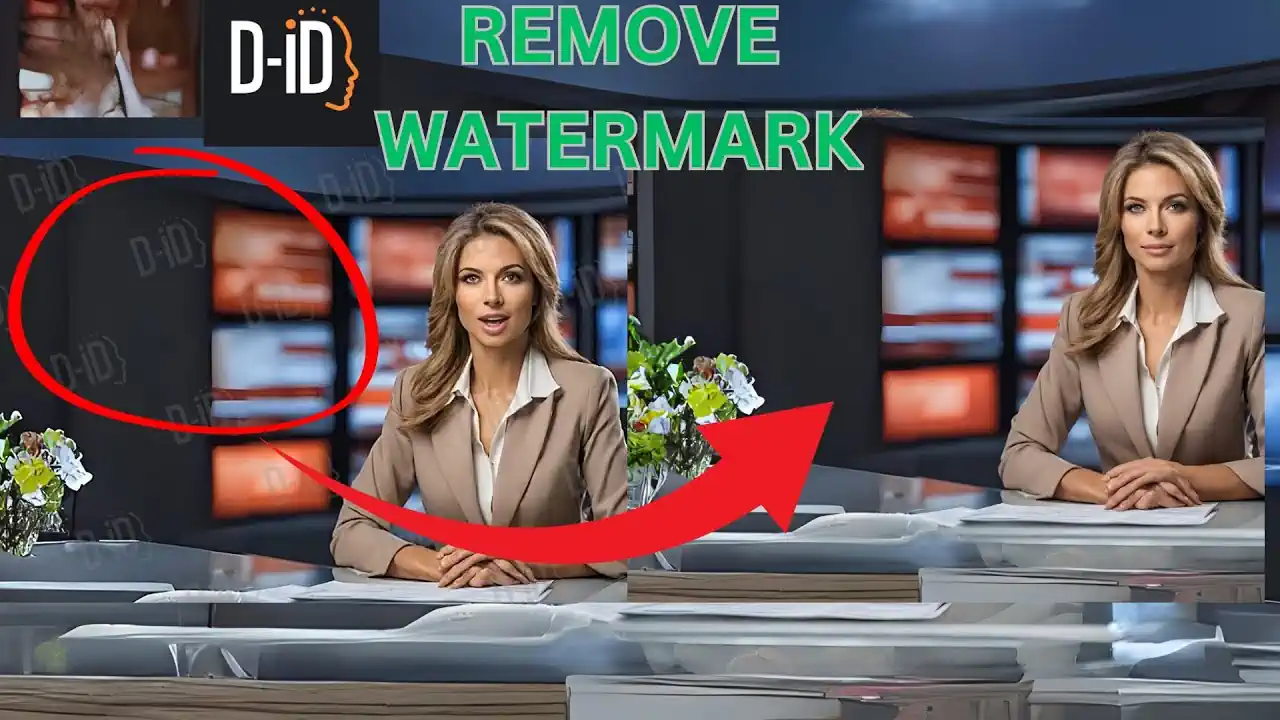Easy Tutorial: Remove D-ID Watermark in 2 Minutes
Have you ever taken a great photo, only to find that it has an annoying D-ID watermark across it? It can be frustrating to have your precious memories marred by an intrusive watermark. But fear not! In this easy tutorial, we will teach you how to remove that pesky D-ID watermark in less than 2 minutes. No complicated software or technical skills required. Whether you’re a professional photographer or just someone who enjoys capturing moments, this tutorial will ensure that your photos are free from any distractions. So, let’s get started and learn how to remove the D-ID watermark effortlessly. Get ready for a very easy tutorial that will have your photos looking clean and watermark-free in no time.
Introduction to Removing D-ID Watermark
Watermarks are often used to protect copyrighted material or to claim ownership over digital content. However, there are times when you may want to remove these watermarks for various reasons. In this article, we will address some frequently asked questions about removing watermarks.
One common question is how to remove a D-ID watermark in less than 2 minutes. Well, the good news is that it’s actually quite easy. There are several online tools and software available that can help you remove a D-ID watermark quickly and efficiently. These tools use advanced algorithms to analyze the image and erase the watermark without compromising the quality of the photo. Simply upload the image with the D-ID watermark and let the software do the rest. It’s a simple and straightforward process.
Another frequently asked question is whether removing watermarks is legal. The answer to this question depends on the specific circumstances. If you are removing a watermark from your own copyrighted material, then it is generally legal. However, if you are removing a watermark from someone else’s copyrighted material without permission, it may be considered copyright infringement. It’s always best to seek legal advice if you are unsure about the legality of removing watermarks in a particular situation.
Finally, people often wonder if there are any disadvantages to removing watermarks. While there are generally no downsides to removing watermarks from your own content, it’s important to recognize that watermarks serve a purpose. They protect the integrity of the original creator’s work and discourage unauthorized use. By removing watermarks, you may be encouraging the unauthorized use of the content. It’s essential to consider the ethical implications and respect the rights of the original owner before deciding to remove watermarks.
In conclusion, removing watermarks can be a simple and quick process, but it’s important to be mindful of the legal and ethical considerations involved. Whether you are removing a D-ID watermark or any other type of watermark, make sure you have the necessary rights to the content and understand the potential implications of removing the watermark.
Why Removing Watermarks is Important
Are you tired of having your photos and videos ruined by an annoying D-ID watermark? Well, you’ve come to the right place! In this tutorial, we will show you how to remove the D-ID watermark from your media files in less than 2 minutes. Yes, you heard it right – it’s that easy!
Before we get started, let’s briefly discuss what D-ID watermark is. D-ID, short for Digital Identification, is a technology used to protect digital media from unauthorized use and copyright infringement. While its intentions may be noble, the watermark can often be an eyesore and ruin the aesthetic of your visual content.
Now, let’s dive into the tutorial. To remove the D-ID watermark, you’ll need a third-party software or online tool. One popular option is the D-ID Watermark Remover, which offers a user-friendly interface and efficient results. Simply upload your photo or video to the tool, select the watermark area, and let the magic happen.
Once the process is complete, you can download the newly watermarked-free media file and enjoy it without any distractions. It’s important to note that removing watermarks from copyrighted content without proper authorization is illegal, so make sure you have the rights to the media before proceeding.
In conclusion, the process of removing D-ID watermarks is quick and easy, thanks to various software and online tools available. Whether you’re a professional photographer or simply want to enhance your personal photos and videos, this tutorial provides a solution to make your visual content more appealing. Just remember to respect copyright laws and use this technique responsibly.
Tools Needed for Removing D-ID Watermark
If you’ve ever come across a photo or video with a D-ID watermark that you want to remove, you’re in luck. In this easy tutorial, we’ll guide you through the tools you’ll need to successfully remove the watermark in less than 2 minutes.
The first tool you’ll need is a reliable photo or video editing software. Adobe Photoshop or Adobe Premiere Pro are excellent choices as they offer a variety of powerful editing tools. If you prefer free options, GIMP or HitFilm Express can also do the job. Install your preferred software and open the image or video file you want to edit.
Next, you’ll need to select the appropriate tool for removing the watermark. In most editing software, this is typically the clone stamp tool or the healing brush tool. These tools allow you to clone or sample areas of the image or video that don’t contain the watermark and use them to cover up the watermark seamlessly.
Once you’ve selected the tool, adjust the size and hardness of the brush according to the size and intensity of the watermark. Carefully paint over the watermark, taking care to match the surrounding colors and textures. Zoom in on the image or video for more precise editing.
After you’ve finished covering the watermark, carefully review your work and make any necessary adjustments. Finally, save the edited image or export the edited video file in the desired format. Congratulations, you’ve successfully removed the D-ID watermark!
Remember, watermark removal should only be done for personal use or if you have permission from the copyright holder. It is important to respect intellectual property rights and only use this tutorial ethically and responsibly. With the right tools and a little practice, you’ll be able to remove D-ID watermarks with ease.
Step-by-Step Guide to Removing D-ID Watermark
If you’ve ever wondered how to remove a D-ID watermark from your images, you’ve come to the right place. In this step-by-step guide, we will show you exactly how to do it in less than 2 minutes. Don’t worry, it’s a simple process that doesn’t require any technical skills or expensive software. So let’s get started!
Firstly, you need to open the image that contains the D-ID watermark in an image editing program. There are many free options available online, such as GIMP or Paint.NET. Once the program is open, locate the “Clone Stamp” or “Healing Brush” tool. This tool allows you to copy pixels from one area of the image to another, effectively removing the watermark.
Next, select the tool and adjust its settings according to your needs. Make sure the brush size is appropriate for the size of the watermark. Now, click on an area near the watermark that is similar in color and texture. Hold down the “Alt” or “Option” key and click to sample the pixels. Then, release the key and start painting over the watermark, blending it with the surrounding pixels. Take your time and be patient to ensure a seamless result.
Once you have removed the entire D-ID watermark, save the image in a format of your choice. Congratulations! You have successfully removed the D-ID watermark in less than 2 minutes using this very easy tutorial. Now you can share your image without any distractions or attributions. Remember to always respect copyright when using someone else’s work and obtain proper permissions if necessary.
Tips for a Quick and Effective Removal Process
Have you ever come across a photo online that you wanted to use but it had an annoying D-ID watermark? Removing it can seem like a daunting task, but fear not! In this step-by-step guide, I will show you how to remove D-ID watermarks in less than 2 minutes with a very easy tutorial.
Firstly, you will need to find a reliable online photo editor. There are several options available, but a popular and user-friendly one is Pixlr. Simply search for it in your preferred search engine and click on the first result.
Once you have opened Pixlr, click on the “Open Image” button and select the photo with the D-ID watermark that you want to remove. The image will then appear in the editor. Next, click on the “Spot Healing Brush” tool, which is usually located in the toolbar on the left-hand side of the screen.
With the Spot Healing Brush selected, carefully brush over the D-ID watermark. The tool will automatically analyze the surrounding pixels and seamlessly blend them to cover up the watermark. Keep brushing until the watermark is completely gone. Finally, save the edited image by clicking on the “File” menu and selecting “Save”. Choose a location on your computer to save the image, and you’re done!
Removing D-ID watermarks may seem like a complicated task, but with the right tools and a little bit of patience, it can be done in no time. Follow this step-by-step guide and you’ll be able to remove D-ID watermarks in less than 2 minutes with a very easy tutorial. Now you can use those photos without any annoying distractions and enjoy the freedom to use them as you wish!
Alternative Methods for Removing Watermarks
If you’ve ever browsed through the internet, chances are you’ve come across watermarked images. Watermarks are often used by photographers and content creators to protect their work from unauthorized use or to promote their brand. However, there may be instances where you need to remove watermarks for personal or professional reasons. In this article, we’ll answer some frequently asked questions about removing watermarks.
Q: How can I remove a watermarked image?
A: There are several methods to remove watermarks, depending on the complexity of the watermark and the tools you have at your disposal. One common approach is to use photo editing software such as Adobe Photoshop or GIMP. These programs allow you to manually erase or clone areas of the image to remove the watermark. Another method involves using online tools specifically designed for watermark removal. These tools often utilize advanced algorithms to automatically remove watermarks from images.
Q: Can I remove watermarks for free?
A: Yes, there are free options available for removing watermarks. Online tools like Inpaint, Photo Stamp Remover, and D-ID watermark remover are some examples. These tools provide a user-friendly interface and allow you to upload your watermarked image and remove the watermark easily. However, it’s worth mentioning that free tools may come with limitations or may not be as effective as paid alternatives. If you frequently need to remove watermarks or require more advanced features, investing in a paid software or professional services might be a better option.
Q: How to remove D-ID watermark in less than 2 minutes | Very easy tutorial.
A: Removing a D-ID watermark can be done quickly and easily by following this tutorial. Start by uploading the watermarked image to the D-ID watermark remover tool. The tool will then utilize its advanced algorithms to analyze and remove the watermark. Once the watermark is removed, you can download the image without any traces of the watermark. This process can typically be completed in less than 2 minutes, making it a hassle-free solution for removing D-ID watermarks.
In conclusion, removing watermarks from images is possible using various methods and tools. Whether you choose to use photo editing software or online tools, it’s essential to consider the complexity of the watermark and the desired outcome. By following tutorials or utilizing user-friendly tools like D-ID watermark remover, you can easily remove watermarks and make the image your own. Just remember to respect copyright laws and usage rights when handling watermarked content.
Ensuring High-Quality Results After Watermark Removal
Watermarks are often used by content creators to protect their work from being used without permission. However, there are times when we may need to remove watermarks for various reasons. Luckily, there are alternative methods available that can help us get rid of these watermarks quickly and easily.
One popular method is using a dedicated software called D-ID, which stands for Digital Image Denoising. This software has a specific feature that allows users to remove watermarks in less than 2 minutes. It is a very easy tutorial that anyone can follow. By simply uploading the image with the watermark and selecting the appropriate settings, the software will automatically detect and remove the watermark, leaving you with a clean and clear image.
Another method is using photo editing tools like Adobe Photoshop or GIMP. These tools have advanced features that can help remove watermarks. The process involves selecting the watermark area and using the clone stamp or healing brush tool to replicate the surrounding pixels and cover up the watermark. This method may require some level of proficiency in using these tools, but with practice, it can be an effective way to remove watermarks.
Lastly, there are online services and apps available that specialize in watermark removal. These platforms allow users to upload their images and have the watermarks automatically removed. Some of these services may be free, while others require a subscription or one-time payment. It’s important to choose a reliable and reputable service to ensure the quality of the final image.
In conclusion, removing watermarks from images has become easier with the availability of alternative methods. Whether using specialized software like D-ID, photo editing tools like Adobe Photoshop, or online services, it is possible to remove watermarks quickly and easily. However, it’s essential to respect the copyright of others and only remove watermarks from images for personal or legitimate purposes.
Common Mistakes to Avoid When Removing Watermarks
Removing watermarks from images can be a bit of a challenge. Whether you accidentally added a watermark to your image or need to remove one for legal or personal reasons, it’s important to know the right techniques. In this article, we will address some frequently asked questions about removing watermarks and provide a step-by-step guide on how to remove the D-ID watermark in less than 2 minutes.
One common question is whether it is illegal to remove watermarks. While there may be specific circumstances where it is legal, removing watermarks without the owner’s permission is generally considered a violation of copyright laws. It’s important to always respect the rights of the content creators and obtain proper authorization before modifying or redistributing their work.
Now, let’s dive into the tutorial on how to remove the D-ID watermark. D-ID stands for digital image distortion, and it is a method used to protect images from unauthorized use. However, there are cases where you might need to remove it. You can find a very easy tutorial online with step-by-step instructions on how to remove the D-ID watermark in less than 2 minutes. This tutorial will guide you through using a dedicated software or photo editing tools to erase the watermark while preserving the image quality.
Remember, removing watermarks should be done responsibly and with proper authorization. It’s always best to contact the content creator or copyright holder if you require an image without a watermark. Additionally, make sure to understand and comply with copyright laws to avoid any legal consequences.
Final Thoughts on D-ID Watermark Removal
Watermarks are often added to protect images and documents from being misused or stolen. However, there may be instances where you need to remove a watermark without damaging the original content. Unfortunately, many people make common mistakes that can result in poor outcomes or even legal issues. In this article, we will discuss some of these mistakes and provide you with tips on how to remove watermarks effectively and responsibly.
One of the most frequent mistakes people make is using non-specialized software or online tools to remove watermarks. These generic tools may not be designed to effectively target and remove specific watermarks, potentially causing damage to the original content. It is crucial to use professional software that is specifically built for watermark removal, ensuring a clean and accurate result.
Another mistake is not taking the time to understand the legal implications of removing watermarks. In some cases, removing a watermark can be illegal and can result in serious consequences. Always make sure you have the proper rights or permissions to edit or modify the content before proceeding with any watermark removal.
Additionally, not following proper tutorials or guides can lead to unsuccessful attempts at removing watermarks. It is essential to follow detailed, step-by-step instructions from reliable sources to ensure success. There are countless tutorials available online, but be cautious and verify the credibility of the source before following their instructions.
In conclusion, removing watermarks can be a delicate process that requires attention to detail and adherence to legal guidelines. By avoiding these common mistakes, such as using non-specialized software, understanding the legal implications, and following proper tutorials, you can successfully remove watermarks without any complications. Remember to always proceed responsibly and with respect for the original content creators.
FAQs on Removing Watermarks
Removing watermarks from images is a common task for many individuals, whether they’re trying to protect their own work or simply wanting to use an image without any distracting marks. While watermarks serve as a useful tool for copyright and ownership purposes, sometimes they can be a hindrance. This article aims to answer some frequently asked questions on how to remove watermarks.
One of the most common inquiries is the process for removing watermarks quickly and easily. A popular method is using a software or website like D-ID. With their user-friendly interface, removing watermarks becomes a quick and efficient task. In fact, you can find a very easy tutorial on how to remove the D-ID watermark in less than 2 minutes, making it accessible even for beginners.
Another question often asked is whether removing watermarks is legal. The answer to this varies depending on the context. If you own the copyright to the image and are removing the watermark for personal use or to protect your intellectual property, it is generally acceptable. However, if you are removing watermarks from copyrighted images without permission, it may infringe on someone else’s rights and could lead to legal repercussions.
Lastly, people frequently inquire about the quality of the image after removing the watermark. When using reliable software or following proper tutorials, the quality of the image should not be compromised significantly. However, it’s important to note that the original image with the intact watermark holds higher value in terms of authenticity and ownership.
In conclusion, removing watermarks can be done quickly and easily with the right tools and knowledge. However, it’s crucial to respect copyright laws and permissions when using or modifying images. Always ensure you have the necessary rights or obtain permission before proceeding, and remember that removing a watermark may diminish the value and integrity of an image.



.jpeg)






